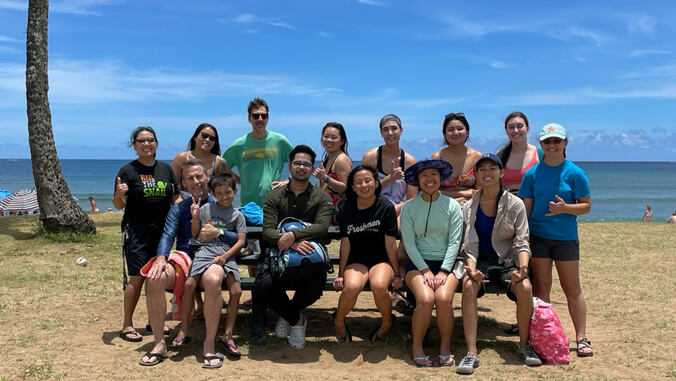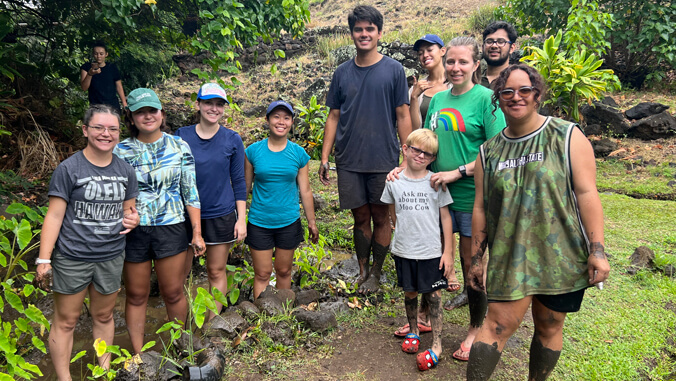
From marine mollusks to pipipi (an endemic snail), promising undergraduate students from colleges across the country researched diversity through a thriving initiative at the University of Hawaiʻi at Mānoa. The 2023 Research Experience for Undergraduates (REU) program, hosted by the School of Life Sciences, welcomed eight students to the 10-week summer program.
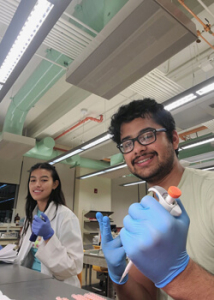
It was the first time the REU program partnered with the Bishop Museum, and six of the students worked jointly between the two institutions to explore biodiversity related research questions.
Biodiversity is the variety of life on Earth, including animals, plants and microorganisms. They all work together to maintain balance and support life. Biodiversity supports everything humans need to survive, such as food, water, medicine and more.
“I really loved my REU cohort. It was nice having a multiple of us working in the same lab and on similar projects because we could help each other out and commiserate when things didn’t work, as well as celebrating together when we got good results,” said Naomi Vilet, a senior at Montana State University studying science education and music education. “As kanaka ʻōiwi (a Native Hawaiian), it was also really meaningful for me to do research in Hawaiʻi and on pipipi specifically, because of their cultural significance and also because they were a food that my grandma enjoyed eating.”
Among the biodiversity-related issues that the students tackled include:
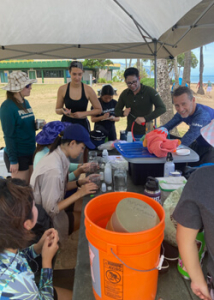
- Assessing the biodiversity of marine amphipods (small crustaceans or sand fleas) on Oʻahu focused on the key organism in ecosystem nutrient cycling and food chains. Despite its importance, there is limited research on marine amphipods in the Pacific. This research is a critical step toward effective conservation during a time impacted by climate change.
- Investigating the use of snail shells by hermit crabs at Haleʻiwa Beach Park discovered that the crabs are using the leftover shells as an adaptation tactic to protect the soft portion (abdomen) of their bodies. This is another example of how animals in the intertidal zone (area covered by high tide and exposed during low tide), which is subject to the constantly changing tide, are adapting to those variable conditions.
- Hawaiʻi’s endemic chitons or marine molluscs facilitate Hawaiian coral reef health and create new coral sand. During a time that Hawaiʻi’s coral reefs are under dire stress due to climate change, this research looks at the evolutionary history of these animals and the possibility that there are new species in Hawaiʻi’s waters.
- An endemic horn-shelled, algae-feeding sea snail called Cerithium boeticum is one of an estimated 119 species of endemic marine gastropods that play a role in the biodiversity of Hawaiʻi’s waters. Since data is limited on the sea snail, this project investigated its evolutionary history.
- Sea hares are marine molluscs that benefit marine areas by consuming algae, potentially mitigating the effects of eutrophication (causes events such as harmful algal blooms, dead zones and fish kills). This project researched their evolutionary history, which will now allow researchers to begin answering more complex questions, such as their role within an ecosystem.
- Pipipi is the Hawaiian name for two endemic marine snail species, Nerita picea and Neripteron neglectum. They reside in the intertidal zone, and there is little to no evolutionary history information about these species. Therefore, samples were collected from Haleʻiwa Beach Park and their genetic sequences were obtained to further our understanding of the marine snails.
The students came from a number of universities, including UH Mānoa, Yale University, Cornell University, Pomona College, UC Davis and Montana State University. They worked directly with Kenneth Hayes (UH Mānoa zoology PhD graduate) and Norine Yeung (UH Mānoa zoology PhD, MS and BS graduate) from the Bishop Museum, Meagan Haubner, a graduate assistant at UH Manoa, as well as REU program coordinators School of Life Sciences Professor Peter Marko and Interim Director of Advising and Professor Stephanie Kraft-Terry.
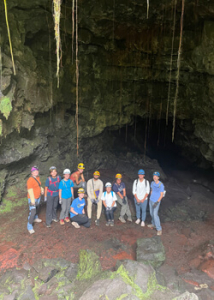
“We’re fortunate to have had a great group of mentors willing to give their time and expertise to the students in the program,” Marko said. “The effort required to provide a meaningful research experience for inexperienced undergraduates in under 10 weeks is far greater than working with most established graduate students, but the payoff can be very rewarding. The rapid transformation in the students, from those acting as passive recipients of knowledge to those actually generating new knowledge over the course of just one summer is amazing.”
“Their time in Hawaiʻi and the research experience left them with a real sense that they could make a real contribution to science and natural biodiversity conservation in Hawaiʻi,” Hayes said. “Hopefully some of these students will go on to become leaders of tomorrow, with a good sense of the rich biodiversity with which we share the world, giving them agency to make a difference.”
Yeung added, “Research is a collaborative endeavor and I hope this partnership between UH Mānoa and the Bishop Museum was able to provide meaningful hands-on experience for students who are interested in studying and exploring Hawaiʻi‘s ecosystems while engaging in research to help conserve Hawaiʻi‘s unique fauna and flora.”
Success of the REU program
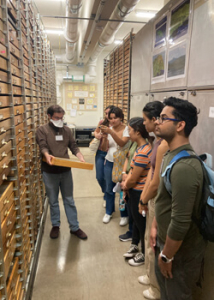
This is the seventh year of the REU program, which provides participants with stipends, and covers the costs of accommodations, food and travel to the REU site. This unique experience allows participants to gain hands-on research experience, providing an excellent stepping stone for future graduate studies. The students are also mentored by a diverse group of faculty from the School of Life Sciences and the Hawaiʻi Institute of Marine Biology. The program is funded by a pair of grants from the National Science Foundation totaling more than $800,000.
“We are pleased that our REU program has successfully trained seven cohorts of students, providing them the opportunity to engage in Hawaiʻi-based research projects,” Kraft-Terry said. “We are excited that over these years we continue to build new and exciting partnerships to support our students.”
—By Marc Arakaki
